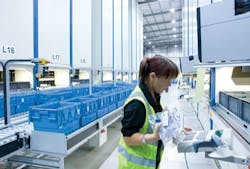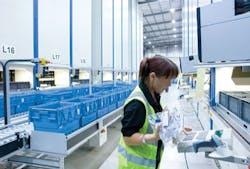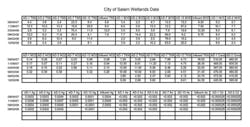Natural Reclamation System Shows Benefit of Wetlands
By Gabi Miles
The Willow Lake Water Pollution Control Facility in Salem, OR, provides wastewater treatment services to the Salem-Keizer metropolitan area and operates under the authority of an Oregon Department of Environmental Quality (ODEQ) administered Federal National Pollutant Discharge Elimination System (NPDES) Permit.
Figure 1: The city of Salem’s Natural Reclamation System totals approximately 10 acres and includes a 0.8-acre overland flow system, a 0.3-acre vertical flow wetlands, a 4.5-acre constructed treatment wetland, and a 4.5-acre constructed habitat wetlands. In addition, 15 acres are allocated for agricultural reuse and an additional 10 acres provide native habitat.
In 1996, the city of Salem commissioned a wastewater management plan to determine the best way to handle wet weather flows in the winter and prevent water quality non-compliance with ammonia in the summer. A natural treatment system was selected as the best method. After adoption of the wastewater management plan, the city began to investigate three separate locations as potential sites for the full-scale wetlands. Each site consisted of approximately 300 acres to allow for the constructed wetlands treatment system.
However, announcement of the potential sites created a public outcry. Neighbors in those particular areas protested in community meetings that the location of the wetlands treatment was unfavorable and should not be “in their backyard.”
In 1999, the city withdrew from development of the full-scale system and decided to embark on a multi-year pilot project to determine whether a constructed wetland approach — a Natural Reclamation System (NRS) — could provide a new way of treating wastewater by using natural systems to polish the effluent. The pilot project allowed the city to obtain necessary data to qualify the use of full-scale wetlands, while at the same time illustrated the benefit of the NRS to both the community and the environment.
The mission of the NRS was to demonstrate the use of natural systems as a sustainable method of polishing effluent, improving water quality, and providing reclaimed water supply and management, as well as to determine whether the process would be appropriate within the Willamette River watershed.
Located on land owned by the city of Salem and adjacent to the Willow Lake Water Pollution Control Facility, the NRS totals approximately 10 acres and includes a 0.8-acre overland flow system, a 0.3-acre vertical flow wetlands, a 4.5-acre constructed treatment wetland, and a 4.5-acre constructed habitat wetlands. In addition, 15 acres are allocated for agricultural reuse and an additional 10 acres provide native habitat.
The project facility actively monitors the effectiveness of the NRS to polish effluent. Of special interest is the capability of the NRS to reduce water temperatures and ammonia concentrations throughout the summer. If this reduction could be accomplished, the use of constructed wetlands prior to effluent discharge into the receiving stream could create a more livable environment for endangered fish species.
Understanding the magnitude of data to be compiled and analyzed to determine the success of the NRS, the city recognized the need for a data management product that could capture the data from multiple sources, store the significant amount of data, and report the data in a format that could be easily used for numerous analyses.
During the time of the pilot design and construction, the city was utilizing the Hach Water Information Management Solution™ (Hach WIMS™ - formerly OPS SQL) to collect extensive information about its operations and treatment processes to ensure compliance with federal and state regulations. Realizing that the solution had additional capabilities to handle the data generated for the NRS, the city decided to proceed with use of the product as their data management tool.
Figure 2: This report shows data captured by Hach WIMS to prepare the required Water Pollution Control Federation permit.
“The Hach WIMS product has been instrumental in the collection of relevant data,” said Stephanie Eisner, NRS Project Coordinator. “Its data capture and reporting capabilities have provided us a comprehensive analysis of the wetlands pilot project.”
To date, the product has compiled pilot-scale testing data for more than five years while the city continues to monitor the NRS. Data collected includes the amount of ammonia entering and exiting the wetlands; the levels of phosphorous, biochemical oxygen demand (BOD), metals, e-coli and annual sediment sampling; as well as many others, including monitoring well data. Temperature and ammonia concentrations have been reduced, but the feasibility of a full-scale wetland in Salem remains in question due to the limited availability of the quantity of land required and the fact that Salem has chosen other methods of treatment for the issues that led to the wetlands being chosen in the first place.
At a time when environmental strengthening is on everyone’s mind, the Salem’s progressive perspective has allowed them to not only recognize and understand a “green” approach that can provide utilities the resources necessary to expand their environmental capabilities but also acknowledge the corresponding use of advanced technologies to provide them with the means to capture, assess, and analyze the information.
“Other customers have utilized the Hach WIMS product to [address] their environmental management needs, but the city of Salem is the first to employ the system as the source technology to capture data associated with an enhanced environmental plan such as the one developed by the city,” said Scott Dorner, Hach WIMS Applications Development Manager. “We applaud the Salem’s forward thinking approach and are proud that the Hach WIMS product was able to be used in such an innovative project.”
The unique NRS approach has piqued the interest of many communities that want to enhance the environment through development of their own wetlands. The city of Salem provides the following “lessons learned”:
The necessity of a data management product that will evolve as the project changes: With minimal modifications, the Hach WIMS system was able to capture the necessary wetlands data to allow complete analysis and preparation of required reports (e.g., Water Pollution Control Federation permits).
The need for public outreach: Recognizing the public’s concerns for the wastewater treatment approach, the NRS pilot project included various opportunities to promote the wetlands to the public. For example, a neighborhood committee was enlisted to assist the city in the review of the designs and issues pertaining to surrounding homes. In addition, a formal mosquito monitoring program was conducted to examine the quantity of mosquitoes (an expressed public concern).
The partnership between Salem and Hach WIMS provides the city, as well as other communities, the ability to invest in the future of their community — and their world.
About the Author:
Gabi Miles is the product/marketing manager for the newly acquired OPS Systems Company at Hach Company, based in Loveland, CO. Hach Company recently purchased OPS Systems, a company with 30 years of experience developing and implementing software solutions for water, wastewater, and industrial applications. Miles has a BS in Electrical Engineering from Colorado University and an MBA from Colorado State University and has over 20 years of software and marketing experience.


